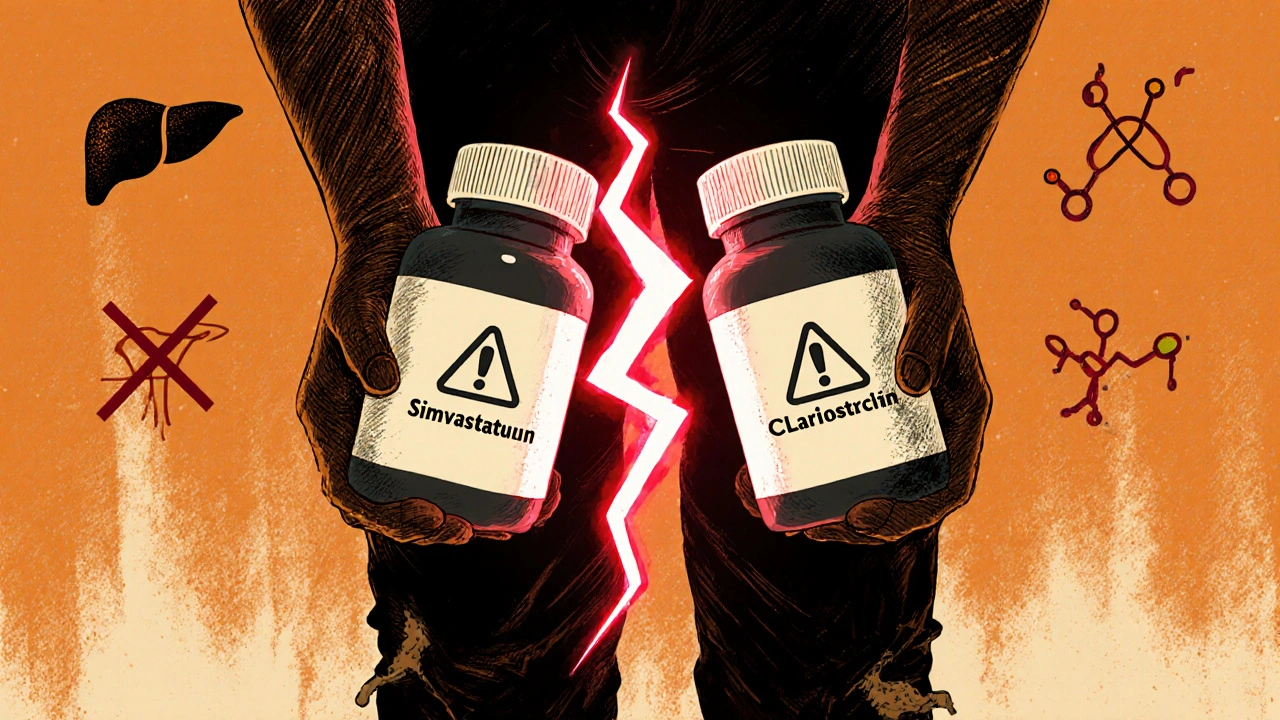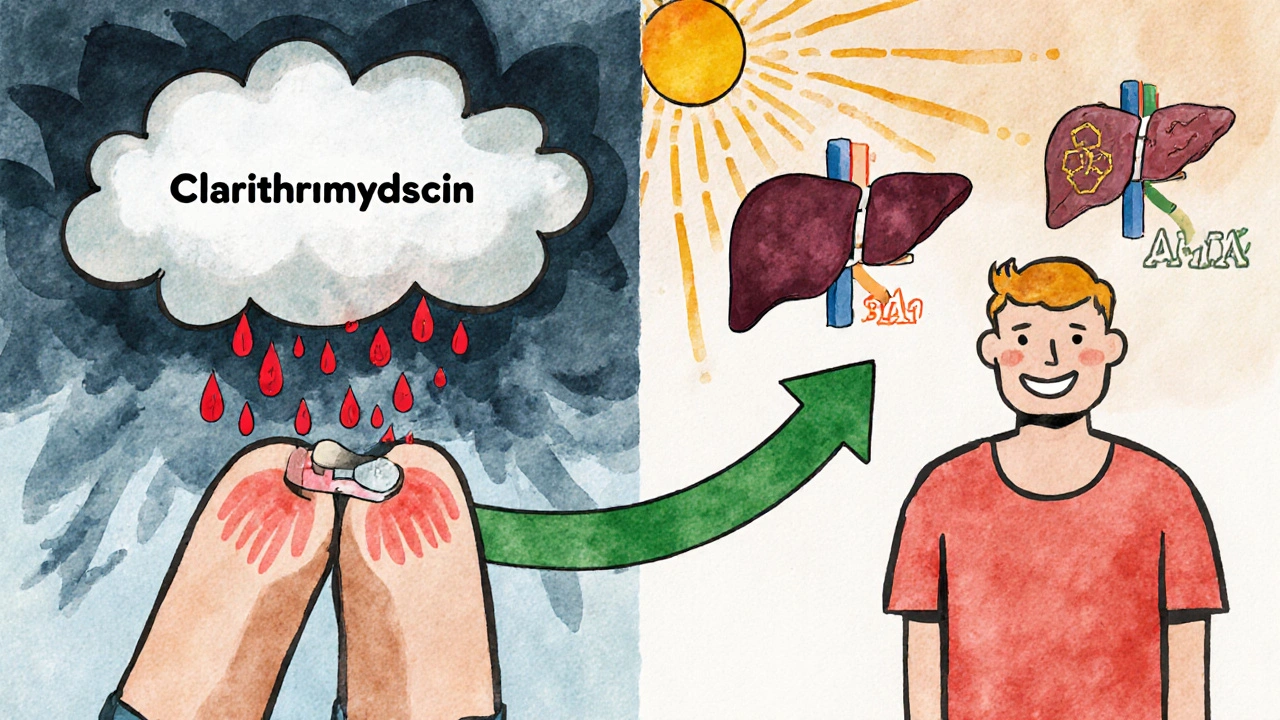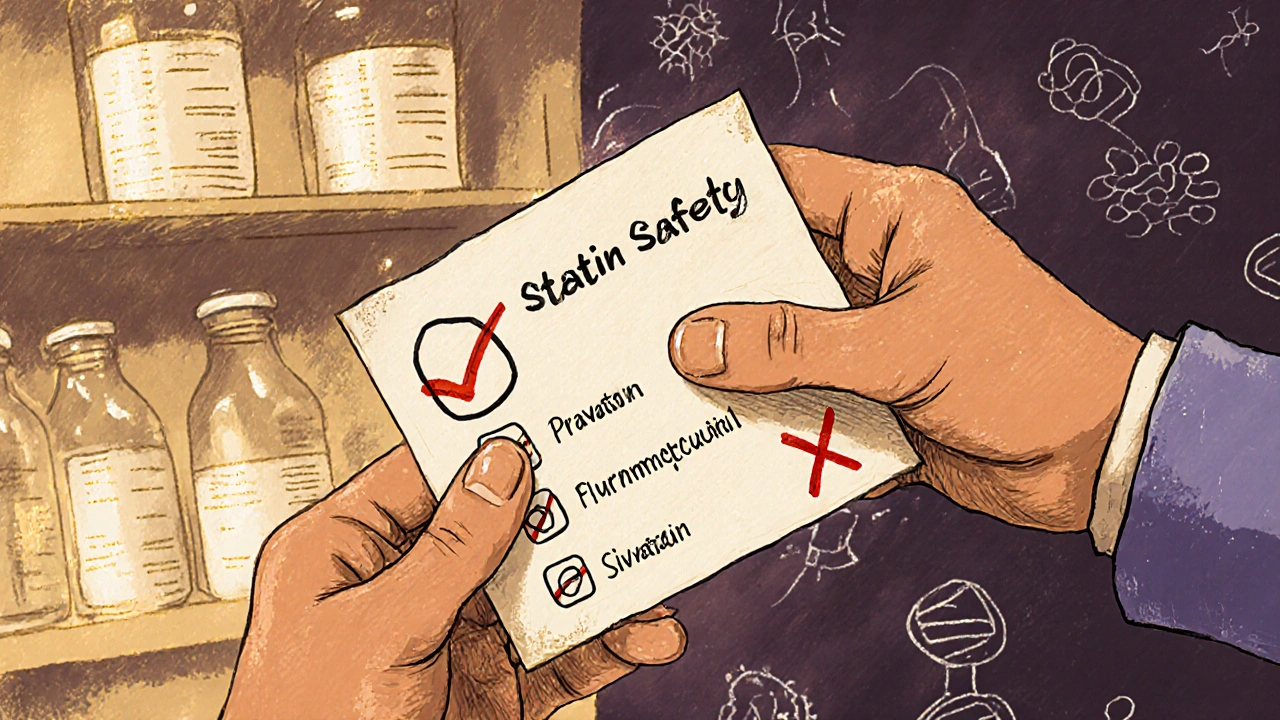Clarithromycin and Statins: How to Avoid Muscle Toxicity Interactions

When you’re on a statin to lower your cholesterol and then get a bacterial infection that needs antibiotics, it’s easy to assume your doctor will just prescribe the first one that comes to mind. But if that antibiotic is clarithromycin, you could be walking into a dangerous interaction that can wreck your muscles - even send you to the hospital.
This isn’t theoretical. Between 2004 and 2013, the FDA recorded 127 cases of rhabdomyolysis - a life-threatening breakdown of muscle tissue - directly tied to clarithromycin combined with certain statins. In one case, a patient’s creatine kinase (CK) levels spiked to 12,500 U/L after taking clarithromycin with 40 mg of simvastatin. Normal levels are under 200. That’s a 60-fold increase. The muscle pain was so severe, they needed morphine. And this isn’t rare.
Why Clarithromycin and Statins Don’t Mix
Clarithromycin doesn’t just kill bacteria. It also shuts down a key liver enzyme called CYP3A4. This enzyme is responsible for breaking down several statins. When it’s blocked, those statins build up in your bloodstream like a traffic jam. The result? Toxic levels that attack your muscle cells.
Not all statins are created equal here. Simvastatin and lovastatin are the most vulnerable. About 95% of simvastatin is processed by CYP3A4. When clarithromycin gets in the way, simvastatin levels can jump 10 to 12 times higher than normal. Lovastatin isn’t far behind. Atorvastatin sees a 4- to 8-fold increase. Even rosuvastatin and pravastatin aren’t completely safe - but their risk is much lower.
The danger doesn’t end when you finish the antibiotic. Clarithromycin’s active metabolite sticks around for up to 10 days. So even if you stop taking it, your body is still struggling to clear the statin. That’s why timing matters - you can’t just skip a few doses and call it safe.
Which Statins Are Safest with Clarithromycin?
If you need antibiotics while on a statin, your best bet is to pick one that doesn’t rely on CYP3A4. Here’s how they stack up:
| Statin | Metabolism Pathway | Plasma Increase with Clarithromycin | Recommended Action |
|---|---|---|---|
| Simvastatin | CYP3A4 (95%) | 10-12 fold | Avoid completely if dose >20 mg. If absolutely necessary, reduce to 10 mg daily. |
| Lovastatin | CYP3A4 | 5-20 fold | Avoid entirely. EMA recommends no concurrent use. |
| Atorvastatin | CYP3A4 | 4-8 fold | Limit to 20 mg daily during treatment. |
| Rosuvastatin | Minimal CYP2C9 | 2-3 fold | Max 20 mg daily. Monitor for symptoms. |
| Pravastatin | Sulfation (non-CYP) | Minimal | No dose adjustment needed. |
| Fluvastatin | CYP2C9 | Minimal | No dose adjustment needed. |
Pravastatin and fluvastatin are your safest options. They don’t go through CYP3A4 at all. If you’re on simvastatin or lovastatin and need an antibiotic, switching to one of these statins - even temporarily - can prevent disaster.
The Better Antibiotic: Azithromycin
There’s a simple fix: swap clarithromycin for azithromycin. Azithromycin doesn’t block CYP3A4. It’s just as effective for common infections like bronchitis, sinusitis, and pneumonia - but it won’t turn your statin into a poison.
A 2013 study in the Canadian Medical Association Journal tracked over 300,000 patients. Those on azithromycin and simvastatin had a 4.6 times lower risk of rhabdomyolysis than those on clarithromycin and simvastatin. Another study found that clarithromycin raised the risk of hospitalization for kidney injury by 60% compared to azithromycin.
One Reddit user shared their experience: “My doctor switched me to azithromycin when I needed antibiotics while on atorvastatin - no issues this time.” That’s the kind of outcome you want.
Doctors still prescribe clarithromycin too often. A 2023 study in JAMA Internal Medicine found that nearly 19% of primary care doctors still give clarithromycin to patients on high-dose simvastatin. That’s over 132,000 dangerous prescriptions every year in the U.S. alone.

What to Do If You’re Already on Both
If you’re currently taking clarithromycin and a statin, don’t panic - but act fast. Here’s what to do:
- Check your statin. If it’s simvastatin or lovastatin, call your doctor immediately. Don’t wait for symptoms.
- Ask for azithromycin. If your infection can be treated with azithromycin, it’s the clear choice.
- Temporarily stop your statin. If you can’t switch antibiotics, pause your statin for the entire course of clarithromycin plus 3-5 days after. This gives your liver time to catch up.
- Don’t reduce the dose alone. Lowering simvastatin to 10 mg might help, but it’s not a guarantee. The safest move is to stop it entirely.
- Watch for symptoms. Muscle pain, weakness, or dark urine are red flags. If you feel this way, get your CK levels checked right away.
The average time to symptoms? Just 3.2 days after starting clarithromycin. That’s faster than most people realize. You don’t have to wait weeks to get hurt.
Who’s at Highest Risk?
Not everyone on this combo will have problems. But some people are far more vulnerable:
- People over 75
- Those with kidney disease
- Patients with hypothyroidism
- People taking multiple medications that affect the liver
- Those with a genetic variant called CYP3A5*3/*3 - which makes them 3.2 times more likely to develop muscle toxicity
Even if you’re young and healthy, don’t assume you’re safe. A 2022 survey found that 68% of statin users had no idea about drug interactions before they got sick. That’s not ignorance - it’s a system failure.

How to Protect Yourself
Here’s how to take control:
- Know your statin. Write down the name and dose. Keep it in your wallet or phone. If you’re prescribed clarithromycin, show it to your pharmacist or doctor and ask: “Is this safe with my statin?”
- Ask for alternatives. Don’t accept clarithromycin without asking if azithromycin is an option. It’s not a big ask - it’s a life-saving question.
- Use a medication app. Apps like Medisafe or MyTherapy can flag interactions before you even fill the prescription.
- Get a statin wallet card. The American Heart Association offers free printable cards listing which drugs to avoid with your statin. Print one. Carry it.
- Report side effects. If you get muscle pain after starting clarithromycin, tell your doctor. And report it to the FDA’s MedWatch program. Your report could save someone else’s life.
The Bigger Picture
This interaction isn’t just about two drugs. It’s about how we manage medications in modern medicine. Statins are among the most prescribed drugs in the world - nearly 39 million Americans take them. Clarithromycin is the third most common macrolide antibiotic. About 700,000 Americans get this dangerous combo every year.
Electronic health records have cut wrong prescriptions by 42% since 2015. But they’re not perfect. And many doctors still don’t think about drug interactions unless they’re staring at a pop-up warning.
The good news? This is one of the most preventable drug dangers out there. Switching to azithromycin, pausing the statin, or choosing pravastatin instead of simvastatin can eliminate the risk almost entirely. There’s no need to gamble with your muscles.
And the future? Researchers are already working on antibiotics that don’t touch CYP enzymes at all. Two candidates, AB569 and SPR720, are in clinical trials. But you don’t have to wait for the next generation of drugs. You can make the safe choice today.
Can I take clarithromycin with a low dose of simvastatin?
Even a low dose of simvastatin (like 10 mg) carries risk when taken with clarithromycin. The FDA recommends avoiding this combination entirely. If you must take both, do so only under close medical supervision with weekly CK tests. But the safest path is to switch to azithromycin or a different statin like pravastatin.
How long should I wait to restart my statin after clarithromycin?
Wait at least 3 to 5 days after your last dose of clarithromycin before restarting your statin. That’s because clarithromycin’s active metabolite lingers in your system for up to 10 days. Restarting too soon can still lead to toxic statin levels. When in doubt, wait longer - it’s better to be safe than sorry.
Is azithromycin as effective as clarithromycin?
Yes. Azithromycin works just as well as clarithromycin for common infections like sinusitis, bronchitis, and strep throat. In fact, it’s often preferred because it’s taken once daily for just 5 days, has fewer side effects, and doesn’t interfere with statins. If your doctor says clarithromycin is better, ask for evidence - most of the time, azithromycin is the better choice.
What symptoms should I watch for?
Watch for unexplained muscle pain, tenderness, or weakness - especially if it’s in your shoulders, thighs, or lower back. Dark or tea-colored urine, fever, nausea, or fatigue are also warning signs. These could mean your muscles are breaking down. If you notice any of these, stop the medications and get a blood test for creatine kinase (CK) right away.
Can I take other antibiotics with statins?
Most antibiotics are safe. Penicillins (like amoxicillin), cephalosporins (like cephalexin), and fluoroquinolones (like ciprofloxacin) don’t interfere with CYP3A4. But avoid erythromycin - it’s similar to clarithromycin and carries the same risks. Always check with your pharmacist before starting any new antibiotic while on a statin.
Are there any statins that are completely safe with clarithromycin?
Pravastatin and fluvastatin are the safest options. They’re broken down by pathways that don’t involve CYP3A4, so clarithromycin doesn’t significantly raise their levels. Rosuvastatin is also low-risk, but still requires caution and a max dose of 20 mg. If you’re on simvastatin or lovastatin and need clarithromycin, switching to pravastatin is the smartest move.
If you’re on a statin and your doctor prescribes clarithromycin, speak up. You have the right to ask: “Is there a safer option?” Most doctors will appreciate the question - and many don’t realize how dangerous this combo can be. Don’t wait for muscle pain to start. Prevent it before it begins.
Statins are just corporate propaganda to keep people docile while Big Pharma rakes in cash anyway
Why not just eat more garlic and call it a day? I’ve been on a raw onion diet for 12 years and my cholesterol’s lower than my ex’s empathy
While the pharmacokinetic interaction between clarithromycin and CYP3A4-metabolized statins is well-documented, the clinical significance must be contextualized within individual risk stratification. The FDA’s adverse event database reflects case reports, not population-level incidence. For low-risk patients with no comorbidities, the absolute risk remains statistically negligible. However, in polypharmacy cohorts with renal impairment, the relative risk elevation warrants precautionary intervention. Azithromycin remains the preferred macrolide in this context due to its negligible CYP3A4 inhibition profile.